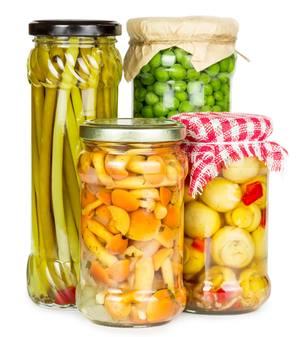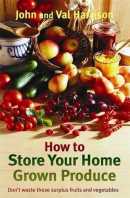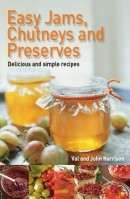The benefit of this method is that fruits do not tend to float to the top of the jar and it is actually quite energy efficient. It does take some skill and practice to get the timing right though.
 A thermometer is really required for this and you might like to have a trial run with a pan full of water to get some idea before you start for real.
A thermometer is really required for this and you might like to have a trial run with a pan full of water to get some idea before you start for real.
The fruit is packed into jar and cold syrup is poured over, as described above. Put the lids onto the jars and then place on a rack or trivet in the bottom of the pan, ensuring there is a little space between the jars.
Cover with cold water and then put a lid onto the pan. Gently heat the water so that it reaches a temperature of 55°C (130°F) over an hour. It has to be gentle heat so that we’re sure the contents of the jar have reached the same temperature as the water.
Now turn the heat up a little and bring it up to recommended temperature over the next half hour. If you don’t have a thermometer this is difficult to measure so bring to simmering point, approximately 90°C (195°F) or use that to try and gauge the temperature.
Once to correct temperature, hold for the required time (see chart below) and then remove the jars to a cooling rack, leaving space between the jars for airflow. Check and tighten the lids. Allow to cool and then label with contents and date before storing in a cool, dark place. Although the produce will store well, light can cause discolouration. One day someone may start selling dark glass preserving jars, buy them!
Double check the seal on the lids is tight the next day when the jars are at room temperature. The way to do this is to carefully undo the clips or unscrew ring sealed jars and then gently lift by the lid. If there is a good seal, the lid will stay on due to the vacuum in the jar. Where you are using the thin metal lids, check if the centre of the lid can be depressed. If it is flexible then it has not sealed correctly.
With metal screw rings, a rub over with a little Vaseline will prevent corrosion and ensure it unscrews easily after months on the shelf.
If the seal is broken then you can re-process the fruit and syrup separately but be aware the quality will not be so good. Alternatively place in the fridge for use over the next couple of days.
Slow Water Bath Method Temperature & Time Chart
Bring to simmering temperature as described above and then hold for the time listed. Timings are based on jars up to 1 quart (1 litre) size
| Fruit | Ideal Temp | Time (mins) |
|---|---|---|
| Apples – in Syrup | 74°C / 165°F | 10 |
| Apples – Solid Pack | 82°C / 180°F | 15 |
| Apricots | 82°C / 180°F | 15 |
| Blackberries / Loganberries / Raspberries | 74°C / 165°F | 10 |
| Cherries | 82°C / 180°F | 15 |
| Citrus Fruits – Orange, Lemon, Grapefruit etc | 82°C / 180°F | 15 |
| Currants – Black, Red or White | 74°C / 165°F | 10 |
| Gooseberries – for cooking in pies etc | 74°C / 165°F | 10 |
| Gooseberries – for uncooked use in desserts | 82°C / 180°F | 15 |
| Peaches | 82°C / 180°F | 15 |
| Pears | 88°C / 190°F | 30 |
| Pineapple | 82°C / 180°F | 15 |
| Plums and Damsons | 82°C / 180°F | 15 |
| Rhubarb – for cooking in pies etc | 74°C / 165°F | 10 |
| Rhubarb – for uncooked use in desserts | 82°C / 180°F | 15 |
| Strawberries – in Syrup | 82°C / 180°F | 15 |
| Tomatoes – Solid pack | 88°C / 190°F | 40 |
| Tomatoes – in Brine | 88°C / 190°F | 30 |
Instructions for Bottling Brine for Tomatoes & Bottling Syrup are here
Safety of Bottled Food
One obvious risk is the seal breaking and allowing microbes access to the food. These will develop and produce gas, often leading to an increase in pressure. With commercial canned goods where the tin has been damaged, a sure sign the contents are spoiled is the can swelling. In the grocery trade, they’re known as ‘blown’.
If you open a home bottled jar and there’s a release of pressure, the food is spoiled. Usually the obnoxious smell will make this very obvious but please don’t trust the food even if it smells OK.
More On Bottling (Canning)
- Bottling or Home Canning Your Produce – Introduction, History, Safety Tips
- Equipment for Home Bottling / Canning
- Methods of Home Bottling / Canning
- Bottling or Home Canning – Preparation of Fruit and Vegetables
- Oven Dry Pack Bottling (Canning) Method
- Oven Wet Pack Bottling (Canning) Method
- Fast Water Bath Bottling (Canning) Method
- Pressure Bottling (Canning)


